Safe In-Wall AC to DC Transformers??
-
Something went wrong with uploading the file, I think.
Herewith a new schematic with a suggested bill of material.
It is highly experimental still, but I ordered the components yesterday.I am specially interested in working with the PTC fuse.
I hope the proposed circuit works for you. Please keep the maximim continuous output power in mind. It is only 3 Watts (600 mA).
In some cases you might need to add C1's (rule of thump 1 per chip or chip VCC) and/or need to increase the value of C2. This depends on the fluctuations in the power demand.With the proposed values for C1 and C2, the ripple remained below 50 mV at 500 mA.
Also keep in mind that a remaining oscillation frequency residue appears in the output of some 60kHz.. If capacitors are not able to filter that out, a small coil might be needed.Well it is experimenting that makes this fun, isn't it?
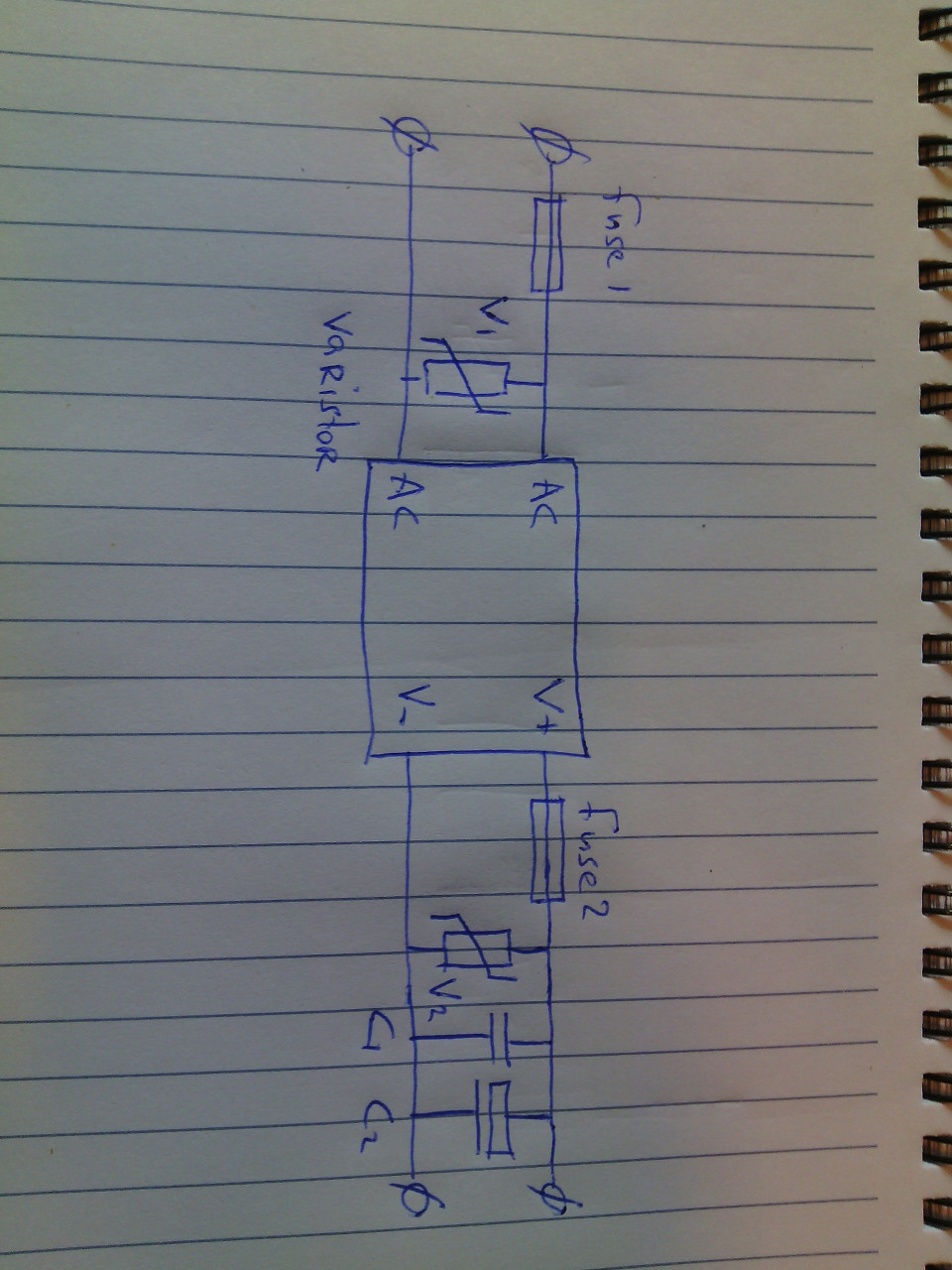
-
@rvendrame said:
Hey guys, I wrote to the owner of the site suggested by @Moshe-Livne. He replied saying that he can test the HLK.
He mentioned that usually he takes at least two units (so if one burn he can continue the testing). I will send one from my lot, perhaps we have a brave guy to gave up one more? (a sacrifice of few to save many )
 Let me know and I will share the address via PM (Denmark).
Let me know and I will share the address via PM (Denmark).I am in for this.
-
@rvendrame said:
Let me know and I will share the address via PM (Denmark).
I will send him a powersupply too.

-
@Bertb can now see the scheme! thanks. But can't see the BOM
-
... it must be friday ...
-
-
As you please ...
-
-
I managed to borrow a Megger (high voltage resistance measurement device). This weekend I will test the insulation of the MLK.
The only drawback is that the Megger reaches to 1000 Volt.
-
@Moshe-Livne said:
@rvendrame Considering cost of postage and logistics involved it would probably be cheapest to just order two units from Ali to him? its 8$ including shipping if i remember correctly
Yes, it makes all sense. The only downside is that if we buy all at same time probably he will get all from the same lot, but in my opinion it by far doesn't invalidate the testing.
So, myself, @Bertb , @Didi = 3 PSUs, better than 2. I will share with you both the ship-to address ok? Thanks a lot!
-
@rvendrame said:
So, myself, @Bertb , @Didi = 3 PSUs, better than 2. I will share with you both the ship-to address ok? Thanks a lot!

-
I'm really happy to hear that these HLK power modules are considered to be safe. I've been using them for a few weeks already, but didn't have a clue what was inside (and whether they were ACTUALLY safe).
One question regarding the varistor and PTC fuses though:
Any reason (or specifications) why you chose those specific components? I've been looking for myself as well, but came up with slightly different components.Fuse1 and 2: PTC Resettable Fuses 250V 1A TRF250-1000
Varistor1: [10D391K 10K391 390V varistor diameter 10mm AC 250V DC 320V]
(http://www.aliexpress.com/item/Varistor-10D391K-10D-391K-VDR-10K391-Metal-voltage-dependent-resistor-50pcs-bag/1912418587.html)Varistor2: [5.5V Varistor original Varistor resistor]
(http://www.aliexpress.com/item/SMD-1206-5-5V-Varistor-original-Varistor-resistor-100pcs-lot/32243046238.html)If anyone with a bit more experience could have some feedback on these components, that would be really really appreciated!!
-
@rvendrame said:
@Moshe-Livne said:
@rvendrame Considering cost of postage and logistics involved it would probably be cheapest to just order two units from Ali to him? its 8$ including shipping if i remember correctly
Yes, it makes all sense. The only downside is that if we buy all at same time probably he will get all from the same lot, but in my opinion it by far doesn't invalidate the testing.
So, myself, @Bertb , @Didi = 3 PSUs, better than 2. I will share with you both the ship-to address ok? Thanks a lot!

-
@aproxx I would say that the 50 mA fuse is too weak. The HLK draws between 0.1 and 0.2 Amp and can surge 10 Amp. So, I think the 1A version is good for both situations input and output. The varistor is only good for the output.
One thing to consider though. This is also chinese stuff ... is it really safe or are we introducing a new problem?
-
@Bertb Aaah yes now I see. It does seem to draw much more peak current than I expected! Then I'll just use the same component as I'm using for Fuse 2.
What do you mean by "The varistor is only good for the output."? You're using one as input and one as output in your diagram as well or am I missing something?And yes, I know this is Chinese stuff again.. But single (chinese) components never failed on me (until now).

-
@aproxx The only varistor I see in your list is 5.5 Volt.
-
@Bertb I see what is getting both of us confused.
Apparently something was wrong in the link of my previous post, resulting in the 2nd varistor not being listed. So now your comment about the varistor only being good for the output makes sense as well.
I've fixed the link of my post above!
-
@aproxx This is a different kind of notation, but when I look the device up in de Bourns catalog, I see it is rated for 250 Vac. That should be good.
-
Short update ... yesterday I asked or Chinese friends from Alie to send a HLK module to our test friend.
I also did an insulation test with 1000 Volt. The test shows more than 1000 MOhm between ac and dc. So far so good.
-
Not a big fan of soldering SMD components and I cannot find standard components, how essential is the 2nd fuse and varistor on the 5v side?
-
@Bertb said:
Short update ... yesterday I asked or Chinese friends from Alie to send a HLK module to our test friend.
I also did an insulation test with 1000 Volt. The test shows more than 1000 MOhm between ac and dc. So far so good.
-
@Atomfire said:
Not a big fan of soldering SMD components and I cannot find standard components, how essential is the 2nd fuse and varistor on the 5v side?
We are trying to make it as safer as possible... Assuming such modules will stay in a wall box, very close to wires and/or other potential fireable materials, we should try to mitigate risks as much as possible.
As I mentioned above --- This is DIY, also means 'risk it yourself'. Don't tell your insurance company

-
@rvendrame said:
@Atomfire said:
Not a big fan of soldering SMD components and I cannot find standard components, how essential is the 2nd fuse and varistor on the 5v side?
We are trying to make it as safer as possible... Assuming such modules will stay in a wall box, very close to wires and/or other potential fireable materials, we should try to mitigate risks as much as possible.
As I mentioned above --- This is DIY, also means 'risk it yourself'. Don't tell your insurance company

That is why I prefer to use fuses that blow, like the ones I mentioned earlier.
The resettable fuses also get warm. Can't wait for the package from Conrad to arrive. I am dying to do some further testing.With respect to the brave HLK ... it is on for some three days and it is stable.
-
@Bertb said:
That is why I prefer to use fuses that blow,
In the other hand, you have to disassemble the wall box in order to reach regular fuses that eventually blow. So I tend to prefer PPTCs, at least for this 'discovery' phase.
But it is just my personal preference.
-
Thanks everyone for the help! I don't know much about this stuff and I am grateful to you for all your contributions!
I am starting to look at ebay for parts but I was wondering if it would be wise to wait a little longer before I order and more testing is performed? I am excited to start building but I don't want to do anything until it's safe. I know safe is a relative term so I guess I should say safe enough for you all to use in your houses.

Thanks again!
Pete
-
@petewill I think this is a wise decision.
I liked the discussion on this thread, so I have to thank you too.Now it is waiting time. Waiting until the hlk-s arrive at the lab of the test guy.
My Chinese friend said, the package is on its way.
-
Mine is on the way too.
-
@Bertb thanks, will do. The waiting is the hardest part

-
Just a heads up. Yesterday I blew up this module, which I bought some time ago (before we invest into the HLK analysis).
I really don't know what happened, it simply exploded without any further notice (and very near my face, like 30cm or so). I was calibrating the power sensor. Dummy I was, trying to find why it was measuring 10W while the PSU is rated 3W...
The sensor is based on a current transformer TA12-100 , measuring itself on ACMains.
Perhaps some old-school guy can tell me if I violated some some basic rule? I want to believe that some scrap wire or metal has shortened some track, but how to prove it?
Well after that, I measured the arduino + radio + measurement circuit and it never crossed 30mA... I also replaced the damaged PSU (by one identical), and now the power sensor measures 4W (instead the previous 10W), and despite some noising capacitor, no heat or instability after 12 hours or so on.
Pictures of the occurrence:
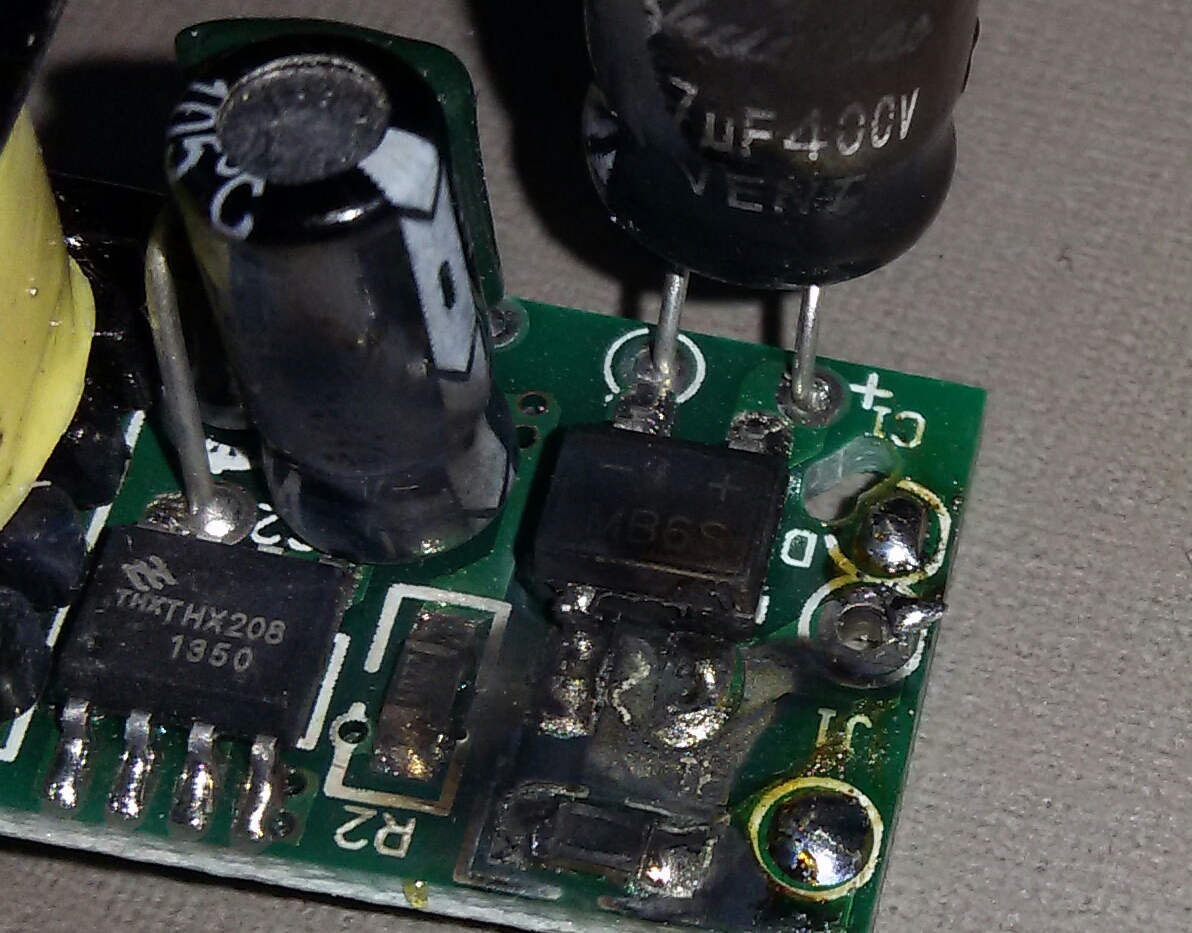
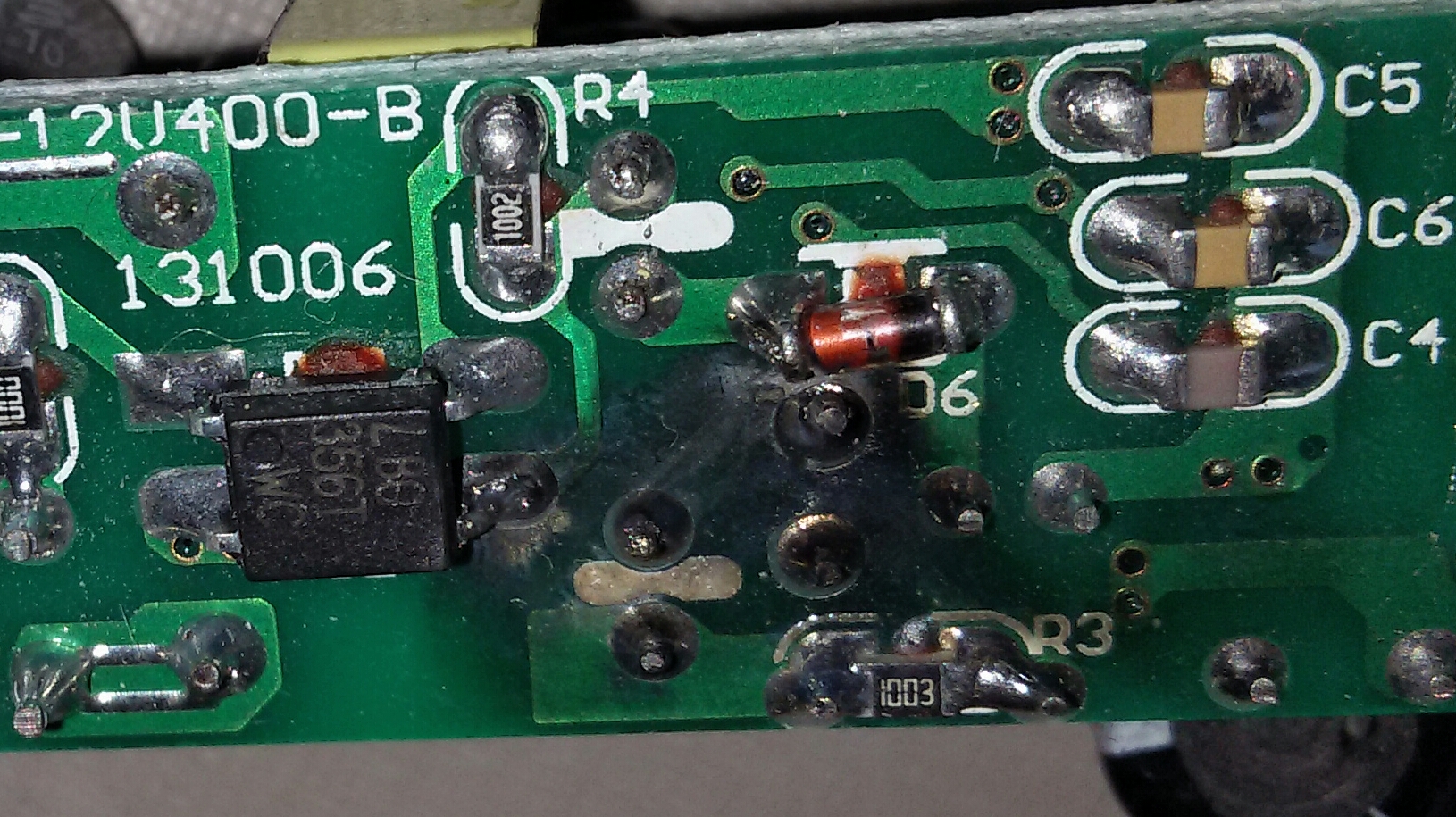
Botton one is the damaged one:
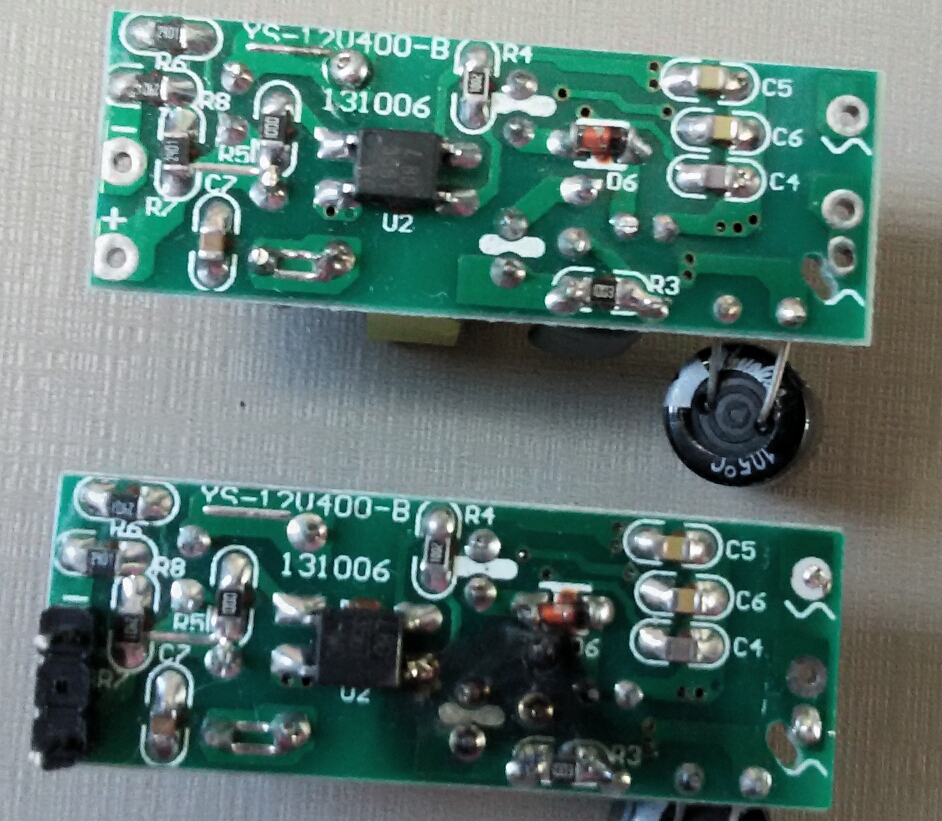
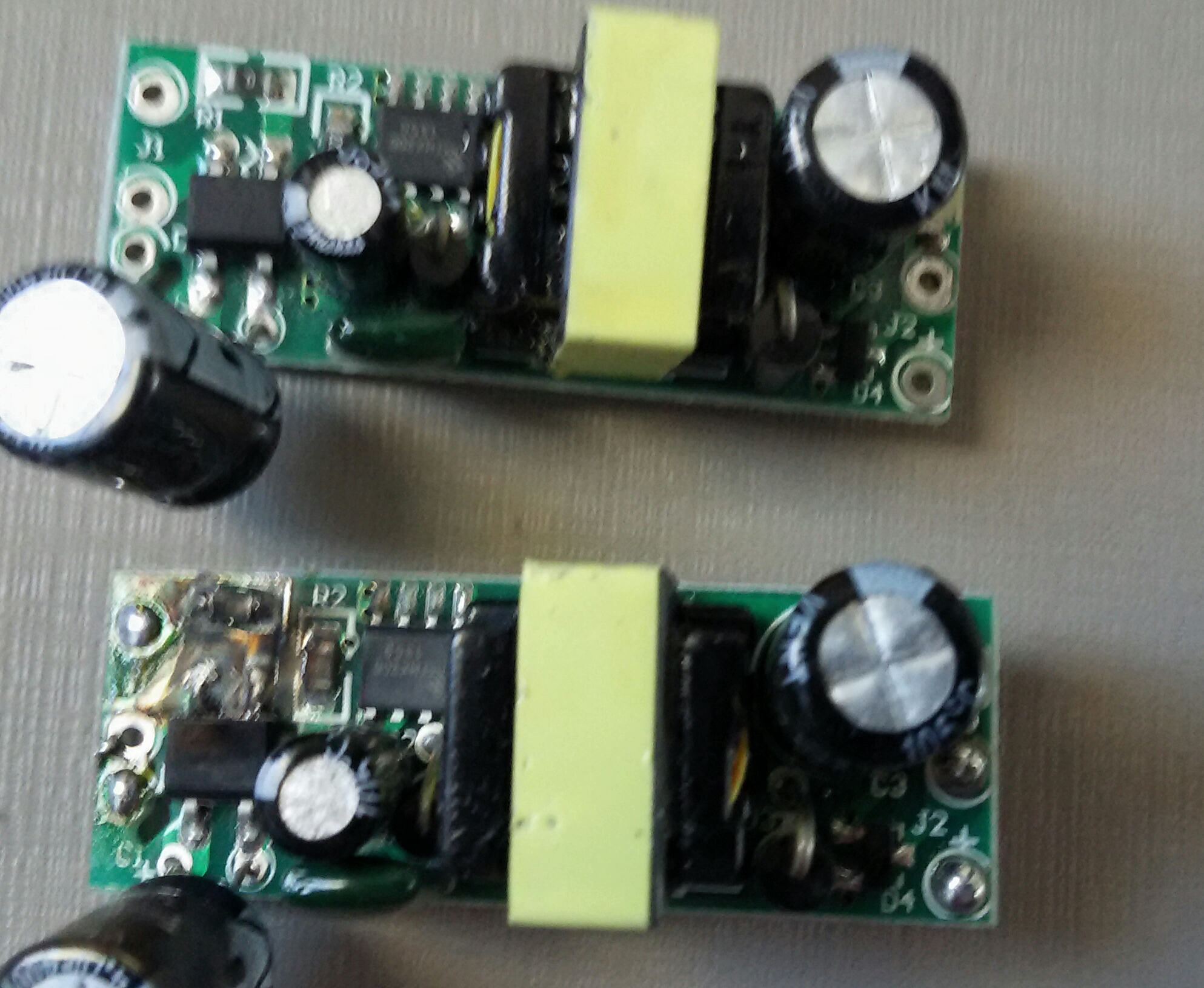
-
@rvendrame Whatever happened (looks like something went to ground; were you probing with a scope?), that MB6S was the source, because that rectifier is blow out.
I don't think you will be able to buff that one out...

-
@ServiceXp , no
-
@ServiceXp , no oscilloscope. I was Cheking why the power sensor was measuring 10w instead 3w or less.
The CT sensor was around the mains phase wire, and the psu was powering the sensor. I didn't change anything , just multimeter readings on DC side. Didn't touch the ac mains except to insert the current transformer around it.
I also connected a light bulb on same wire, in order to generate some load. The sensor was measuring the bulb correctly, however when the bulb was disconnected it read 10w, away too much for only an arduino.
-
@rvendrame I'm not sure if I really get your setup, but ground loops can be a very nifty cause of all kinds of stuff getting 'too hot'

Could this be the cause of the problem?
That 0 ohms resistor also looks like it been fried. What's its use on the board?
-
@rvendrame Hard to say then, but I'd bet an ice cream sandwich that something went to ground/neutral. It's the high voltage side that is blown out of that rectifier.. You may never know what the cause was.
-
@petewill when you start home automation at that time please share photos wit me.
how to setup the no. of relay, power supply, arduino, radio etc in WALL box.
-
@jemish yes, that's the plan. Once all the geniuses figure out how to do it I plan on making a how to video

-
Is there any news from the test guy?
-
yes , is there any news
-
@Didi, did you end up doing horrible things to these? You said something about flashbox?
-
If the fellow behind http://lygte-info.dk/info/usbPowerSupplyTestHow UK.html posts good results on his website, the supply chain should prepare for a flood of orders! I've seen those tests widely referenced, and I think a lot of people are looking for something safer but still cheap.
Don't be surprised if a positive review made it to HackaDay and the like as well.
(Get your ali orders in now, beat the rush - if you think it will come out well)
-
I'm also looking forward about test results. I've seen the module however never totally trusted; until I found this topic. The price and size are perfect for under-socket installation. If further results come out good, I'm eager to see in-wall projects.
-
This one is not "safe", but it is an In-Wall AC to DC converter. Transformerless. With a 3A Solid state relay:


The converter output is 3.3V at 100mA and the solid state relay is a Triac.
-
Looks very nice, but you cannot use it for sensors or actuators that can be touched by hand and do not comply with the insulation standards, since parts of it will be connected to mains.
-
@Bertb Yes, it shouldn't be touched. It can be used with wall-mounted mains switches, though. Placed behind it.
-
Did anyone look at the SwitchMote PSU over at LowerPowerLab? More info here. The kit is fairly expensive ($30) but I wonder how much it would be to source the components yourself since someone else has done all the design work.
-
@TD22057 I would say the cost of this PSU is dominated by the Recom converter onboard. Farnell charges E14,58 for single pieces (http://nl.farnell.com/recom-power/rac02-05sc/ac-dc-converter-2w-5v-reg/dp/1903060?searchRef=SearchLookAhead).
Rest of the components will be a few Euro's, and ofcourse the PCB (which contains a number of milled slots for isolation).
All together you will get fairly close to $30 when building it yourself.
-
@ceech said:
Yes, it shouldn't be touched
Nice! just label board !LIVE!
Not safe due to no fuse? Do share, making your own boards with solder mask?
-
@DrJeff the board is not isolated from mains by e.g a transformer. This means traces carry live mains!
-
So basically it is like any other consumer Zwave switch or X10 just box it up (3D printer on stand by) with 2 micro buttons with a rocker face and I want 10.
 But sorry I digressed from the OP in my excitement.
But sorry I digressed from the OP in my excitement.
-
@DrJeff As @Yveaux said the board does not have an insulation transformer. Yes, I make them. And it works fine, placed inside an enclosure is as safe as it could be. Would you make a box for it? I can send you one board if you like, for the measures.
-
@ceech Yes I like the idea of course the board would be housed inside of a box, my idea is to incorporate the box with a daughter board with 2 push buttons on and off like Zwave switches use. Yes please send me, if you are worried I will use safely I was taught to work on all power 120v - 480v as if it is live so that you remain alive!
-
@DrJeff All right, send me a message with your address and I'll send you one.
-
Another China iphone plug destroyed.
This has been working for 2-3 weeks without problems... the plug runs a 5v arduino and a normal 240-5v relay with button and led, standard sketch.
One day it just didnt started and i opened it up and saw a melted plastic cover and some burned component.
I have felt the relays a couple of times and noone has been really hot.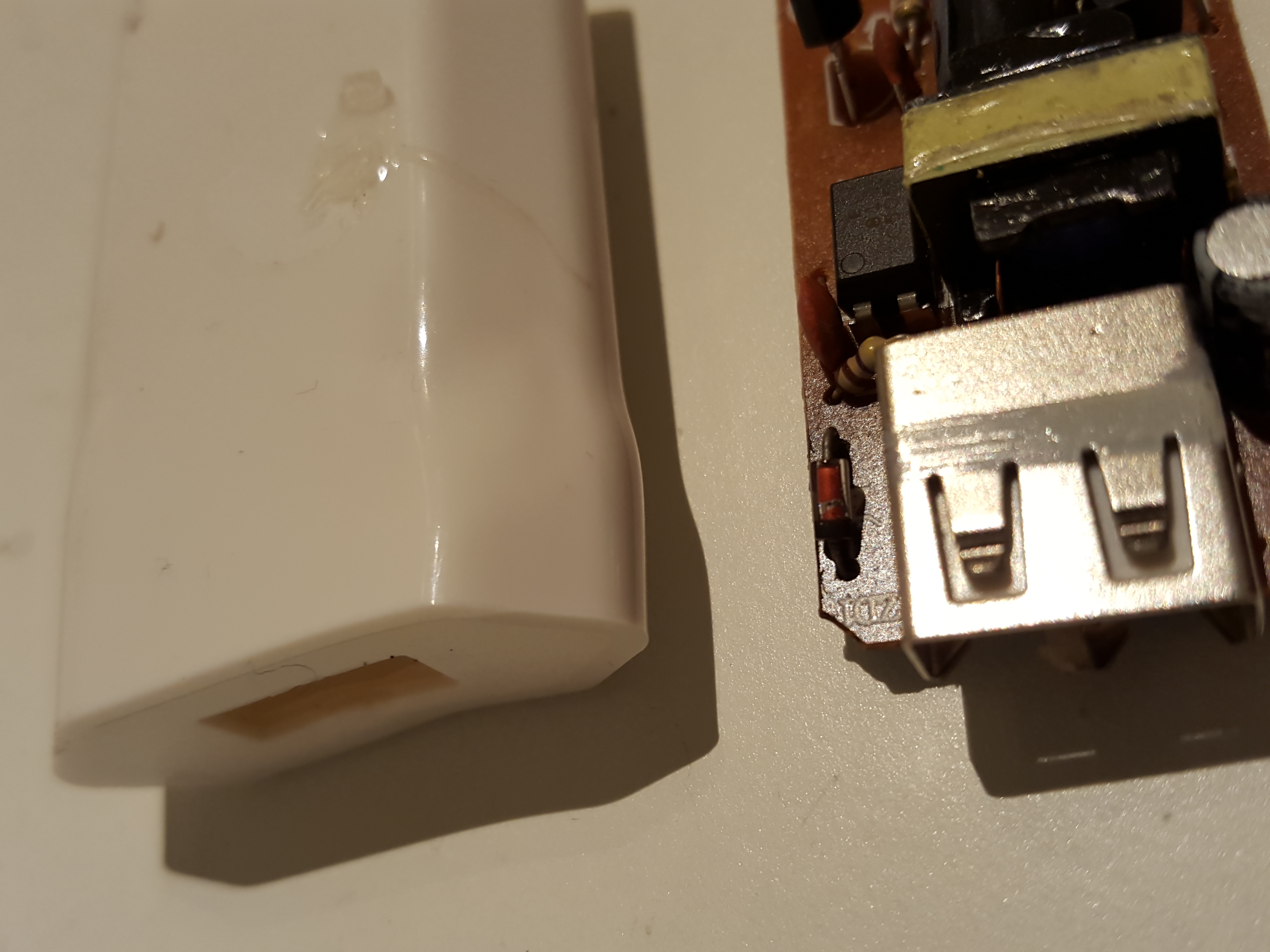
Im getting a bit shaky here... how far from disaster (big fire) is this?
-
BTW, the review of HLK PSU should be published in 'few days' according to the guy from http://lygte-info.dk . Can't wait for that!
-
@sundberg84 Yikes! That is exactly why I started this thread. I don't want to burn my house down...
@rvendrame Awesome! Can't wait either!
-
The review of the hlktech's HLK-PM01 is available here!
-
Thank you for the test.
-
This is fantastic news!!
Would anyone be able to provide a parts list and wiring diagram based on the recommendations from the test site (pasted below)?
"A few notes for using it:
Electronic wears down faster when warm, especially capacitors, i.e. keep it as cool as possible for long lifetime.
I would place a fuse or fusible resistor before the converter, the fuse is not supposed to be replaceable, when it blows it is time to replace the converter.
A MOV accross the mains input would probably also be a good idea."
http://lygte-info.dk/review/Power Mains to 5V 0.6A Hi-Link HLK-PM01 UK.htmlOnce we have a that info I will update the first post so everyone reading this in the future doesn't have to read through 200+ posts to get to the conclusion. Thanks to everyone who helped with this!!!
-
The wiring is easy to describe.
Put a fuse in line between the "hot" mains AC input and the power supply module input (the "neutral" can go directly to the power supply). Put a MOV across the power supply input (on the PS side of the fuse).
For small spikes, the MOV would protect the PS by absorbing most of it. For longer surges, the MOV would cause the fuse to blow, probably sacrificing itself in the process.
Maybe others can help with component selection (for 120v and 240v mains). I see that in the case of Littelfuse, the fuse is rated by RMS AC voltage, so a 140v MOV would work for a nominal 120VAC mains). http://www.littelfuse.com/~/media/electronics_technical/application_notes/varistors/littelfuse_selecting_a_littelfuse_varistor_application_note.pdf
I don't know if RMS rating is standard, or if some are rated by their DC voltage conduction threshold, but one would want to be sure of that for the brand they are getting.
-
Some more thoughts from the guy who analyzed it:
"Hi Ricardo
It looks safe enough to me, except I want a fuse or fusible resistor before it. The purpose of the fuse is to blow when the module is worn down and maybe shorts. How fast it wears down will depend on temperature, at very high temperature it might be less than ½ year, at more moderate temperature it might be 10-20 years. The main culprit is the capacitors, their lifetime depends on temperature and quality of the capacitor.
Second risk for failure is large transients on the mains that may damage the module, again the fuse is there to prevent things getting out of hand if the module breaks down.The module can get hot if you pack it into the wall, especially if it is inside a lot of insulation. Doing a few test with a DMM and a temperature probe taped to the module inside the wall might be a good idea when running the module near full load.
I do not know the stuff used to fill with, but usual it will not easily catch fire."
-
@rvendrame Thanks for getting this tested - that's a great result. The high temperatures he was testing at are for running at 1A of output but I thought that the 5V line is just for the Arduino and the radio which aren't going to use much current at all right?
-
@TD22057 , exactly, under regular load (< 600ma), the unit should not get that hot. Once I get some time I will try the suggestion, by gluing a temp sensor on the unit and put it behind the wall switch.
Perhaps I will add the temp sensor permanently as a extra mySensor on the wall-relay, so I can capture the temp during the upcoming summer days.

-
Well, I must say, I am very happy with the result. Thanks for the testing.
So, I am already planning to use it in a number of devices. To avoid too high temperatures in confined boxes, it might be a good idea to glue a temperature fuse to it and wire it in series with the live mains wire. When the temperature rises above, lets say 75 degrees celsius, the fuse breaks down.
-
It would also be good to link that temp sensor into the arduino. Then it could send out a "help my temp is to high" message before it shuts down. It should be possible to implement an overheated mode which would just blink a status LED on the front of the device and shuts everything else down until the temperature drops. Using the tricks of running a battery powered node should let the arduino power stay low enough for the PSU to cool down while still checking the temperature every few minutes and running the LED. The fuse would then be a fail-safe backup to the overheated mode.
-
@rvendrame said:
Some more thoughts from the guy who analyzed it:
"Hi Ricardo
*It looks safe enough to me, except I want a fuse or fusible resistor before it. The purpose of the fuse is to blow when the module is worn down and maybe shorts.
Would something like this be OK?
http://www.aliexpress.com/store/product/100pcs-LOT-PTC-Resettable-Fuses-TRF250-080-250V-0-08A-80MA-PPTC-Polymeric-PTC-PolySwitch-DIP/1653204_32267664975.html
-
@mvdarend , I don't have experience to evaluate that. These ones are current-driven, I think it would be nice some fuse that is temperature-driven (despite I don't know even if that exist or what would be the parameters for that...)
-
@Zeph Thanks.
Do you all think a 150v MOV is ok for USA? I found some cheaper than the 140v on ebay but I' like to do it right

I found these fuses but they are 250v. Do you think that would be OK for 120v normal power or do I need to find 150v fuses?
Something like this for the temperature fuse?
http://www.ebay.com/itm/3-pcs-New-KSD-9700-70-C-250V-5A-Thermostat-Temperature-BiMetal-Switch-NC-Close-/141752004726?hash=item210113f076Is there anything else I'm missing that should be included in the circuit? Like others, I was also thinking that adding a temp sensor to the Arduino would be good so I could tell how hot it is in the box at any time.
-
More from the 'guru'
"There is no input fuse, that is the reason I recommend one and it has to be a real fuse that blows, not a fuse that will automatic recover. The only time it is supposed to blow is if the converter blows and then you want the mains permanently disconnected. Probably a 0.2A slow fuse will work."
-
@rvendrame Thanks for the clarification.
-
And a 250VAC fuse is fine to use on 120VAC (and in fact quite common).
-
Ok, how does this look for parts?
70 degree (Celsius) fuses - http://www.ebay.com/itm/10pcs-Thermal-Cutoffs-SEFUSE-Microtemp-Thermal-TF-Cutoff-NEC-Fuses-73-C-240-C-/221560426284?var=&hash=item339607cf2c
.75A fuse - They are fast blow not slow like specified above. Does that matter?? http://www.ebay.com/itm/40Pcs-ELECTRIC-FUSE-FAST-BLOW-0-75A-250VAC-35A-IR-THROUGH-HOLE-/271902224922?hash=item3f4ea2b21a
Is there anything else I'm missing? The goal with all this is to make another "how to" video so I want to make sure I'm not giving people bad advice.
So, it would look something like this (ignore power to radio, didn't have time to wire it):
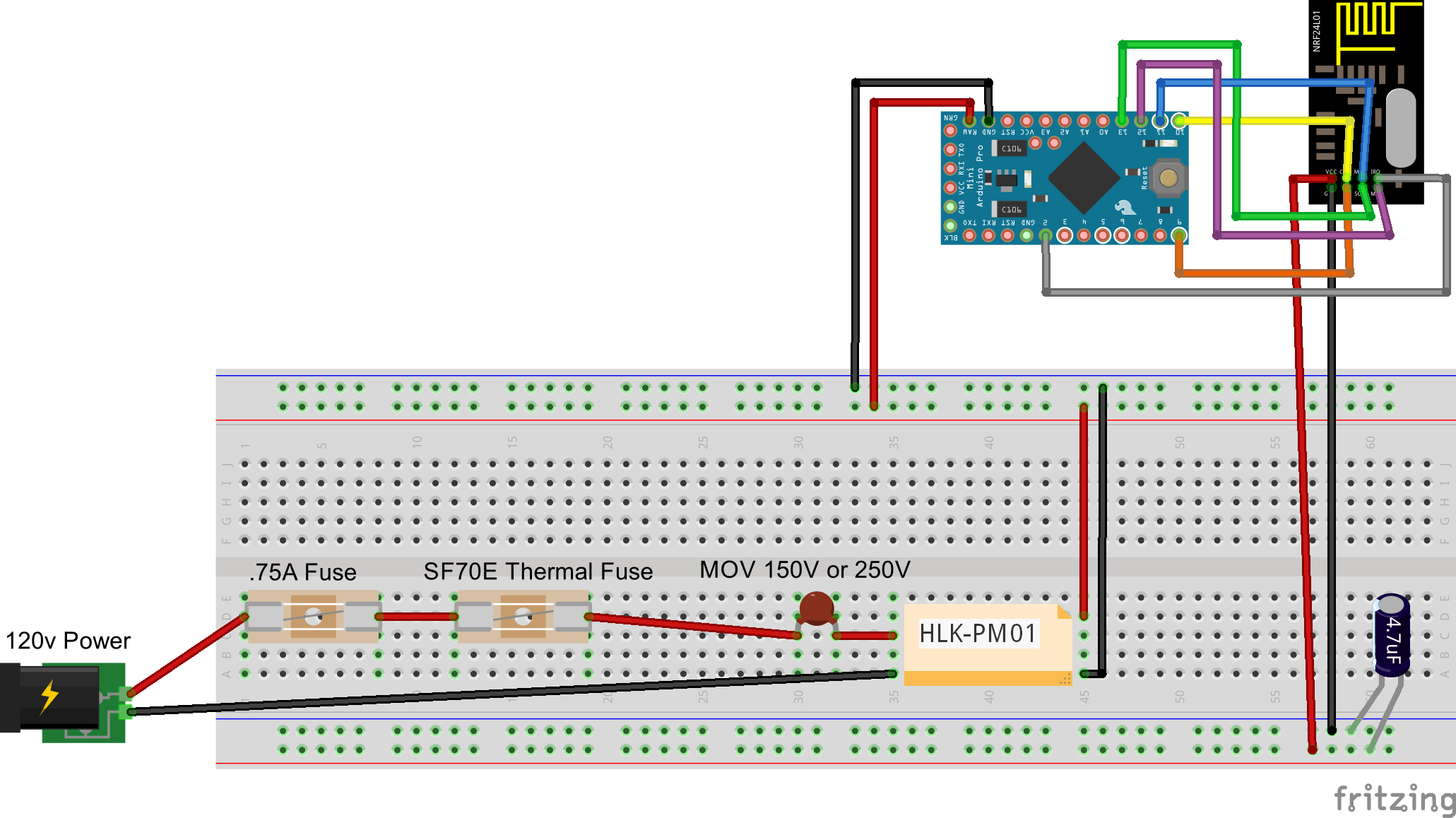
-
@petewill . the MOV goes in parallel with HLK input (and not in series like you did).
It was suggested to use .2A fuses (instead the .75A). And the Thermal fuse should be glued on HLK top (my guess).
-
@rvendrame said:
@petewill . the MOV goes in parallel with HLK input (and not in series like you did).
It was suggested to use .2A fuses (instead the .75A). And the Thermal fuse should be glued on HLK top (my guess).
Dang, totally forgot about all that in my rush to finish the diagram before lunch ended... That's why you guys design the electronics and I make the videos

How necessary are the .2A fuses? I couldn't find any on ebay at a reasonable price. Is the goal of this fuse to prevent large surges (like lightning) from hitting the MOV, or something else? If it's to prevent large surges would the .75A work ok?
Also, I was able to find cheaper varistors. I'm thinking 150VAC should work ok because the HLK is designed to handle 240VAC but maybe I'm off on that?
http://www.ebay.com/itm/5-x-Zinc-Oxide-Varistor-150VAC-15J-1200A-7mm-FREE-SHIPPING-/321024816822?hash=item4abe91f6b6How does this look?
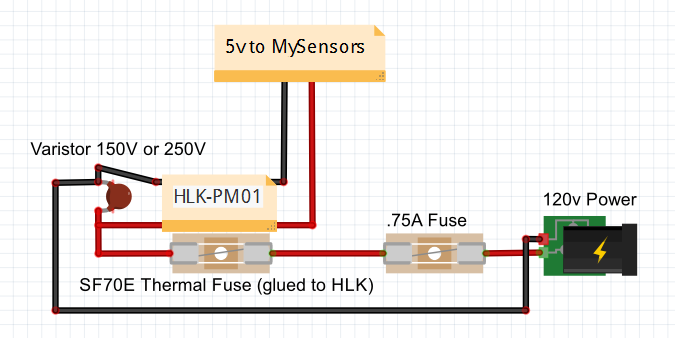
-
@petewill said:
Also, I was able to find cheaper varistors. I'm thinking 150VAC should work ok because the HLK is designed to handle 240VAC but maybe I'm off on that?
As long as you only feed it with 120VAC, there's no issue with that. For those that will feed it with 240VAC, they need to use it with a MOV rated above that.
Cheers
AlPS Here's an option from Digikey: http://www.digikey.com/product-detail/en/MOV-10D241K/MOV-10D241K-ND/2407562
-
@petewill said:
How necessary are the .2A fuses? I couldn't find any on ebay at a reasonable price. Is the goal of this fuse to prevent large surges (like lightning) from hitting the MOV, or something else? If it's to prevent large surges would the .75A work ok?
The fuse serves two purposes, one to protect if the current draw of the power supply exceeds its rated capacity and the other to blow if the varistor starts conducting a large amount of current in a spike situation. A .75A will still provide protection, but will take a longer time to blow. You want to make sure the fuse doesn't blow because of the in-rush current at start-up, which a fast-blow fuse may do. Typically you want the fuse to be sized at about 150% max of the rated capacity so I would not exceed .3A.
Cheers
Al
-
As long as you only feed it with 120VAC, there's no issue with that. For those that will feed it with 240VAC, they need to use it with a MOV rated above that.
I am in the USA so I will only be feeding it with 120VAC, but I will make sure to note that anyone using 240VAC will need a different value varistor.
the fuse should be after the varistor in the circuit
Ok, I'm still a little confused. Are you saying it should be 120VAC -> Varistor -> Fuse -> HLK? Or, 120VAC -> Fuse -> Varistor -> HLK? I thought it was the second one but maybe I misunderstood.
Also, I found some fuses that are rated at 300mA! Not a bad price either!
http://www.ebay.com/itm/Ceramic-Slow-Blow-Fuse-3-6-x-10mm-Axial-Leads-125V-250V-0-1A-6-3A-10-30pcs-/111433875797?var=&hash=item19f1fa0155I think I am almost ready to start ordering parts. I am excited for this build! If anyone else has any feedback please let me know. Thanks!
-
@petewill said:
the fuse should be after the varistor in the circuit
Ok, I'm still a little confused. Are you saying it should be 120VAC -> Varistor -> Fuse -> HLK? Or, 120VAC -> Fuse -> Varistor -> HLK? I thought it was the second one but maybe I misunderstood.
Sorry, the wording I used was unclear and was based on the 120VAC being on the right in your diagram :-). Yes, it is 120VAC -> Fuse -> Varistor -> HLK.
Cheers
Al
-
@Sparkman Great, thanks! The parts have been ordered. Can't wait!
-
@ceech said:
This one is not "safe", but it is an In-Wall AC to DC converter. Transformerless. With a 3A Solid state relay:


The converter output is 3.3V at 100mA and the solid state relay is a Triac.
Do you have some shcematic of this board ? I'd like to adapt it for 2 relays
-
Can anyone give me ebay-links to the parts I need to order to use the HLK with 230V.
I am getting a little confused about all the links.
-
This is the one I sent to be reviewed:
-
Ok thanks, but I meant the fuses, varistors and stuff.
-
@Cliff-Karlsson
I haven't tested any of these parts yet but this is what I ordered. I am in the USA so this is spec'd for 120 VAC. If you're using 240 you will need to change the size of the Varistor but everything else should be fine for 240.Varistor for 120VAC - http://www.ebay.com/itm/321024816822?_trksid=p2057872.m2749.l2649&ssPageName=STRK%3AMEBIDX%3AIT
73°C Thermal Fuse - http://www.ebay.com/itm/221560426284?_trksid=p2057872.m2749.l2649&var=520415979885&ssPageName=STRK%3AMEBIDX%3AIT
250V 300mA Slow Blow Fuse - http://www.ebay.com/itm/111433875797?_trksid=p2057872.m2749.l2649&var=410420838583&ssPageName=STRK%3AMEBIDX%3AIT
HLK-PM01 - http://www.ebay.com/itm/351418782712?_trksid=p2057872.m2749.l2649&ssPageName=STRK%3AMEBIDX%3AIT
-
@Fabien @DrJeff Here is a link to board and schematic files for the transformerless AC-DC converter:
https://github.com/ceech/AC_SR087
-
Would this varistor work with 240v?
http://www.ebay.com/itm/10-x-Zinc-Oxide-Varistor-250VAC-60J-2500A-10mm-/260848704608?hash=item3cbbcb5c60
-
@ceech can't look at the files right now is this a dimmer switch that is transformerless?
-
@DrJeff Yes
-
@ceech Thanks yet again!
-
@MartinP Based on my limited knowledge, yes, that should work. Maybe someone else can chime in to confirm?
-
thank you @ceech
-
@petewill said:
@MartinP Based on my limited knowledge, yes, that should work. Maybe someone else can chime in to confirm?
I would personally go with a higher voltage rating. Something like 15-20% higher than your normal voltage otherwise you may get regular nuisance trips. So for a 240 VAC system, I would use something close to 290V.
Cheers
Al
-
@Sparkman Thanks!
-
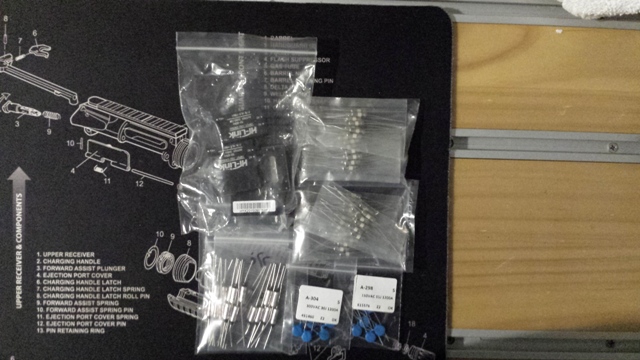

-
@ServiceXp
 long evening ahead
long evening ahead 
-
Hi all,
I was wondering, I want to be able to adress my blinds using mysensors. Using the relay, radio etc works fine, yet I am still wondering on this power supply. So using the above component I basically prevent fire by using the thermal fuse and an overload by using a regular fuse, the varistor and the HLK.
Now, I am using a Nano (I have still 15 of those) which appear to be using 230mA, the radio itself and a relay. The relay (from the spec sheet) uses 180mA. This should be ok to be used with the HLK shown above. Now, my main concern is, how do you make a all sit together nicely? Is there a PCB type of board you are using? Any pointers welcome

Kind regards
Steve
-
Hi Steve
this may be useful http://forum.mysensors.org/topic/1540/110v-230v-ac-to-mysensors-pcb-board
Regrads
Filip
-
@ServiceXp Nice! Let us know how it goes.
-
-
I'm planning on using the HLK-PM01 with the extra precautions discussed here; gluing a thermal fuse on top of the HLK-PM01 and adding a fuse and varistor.
My only problem right now is that I'm unable to find a good source for 0.3A slow blow fuses with axial leads on eBay. The only variants I can find are without leads and it feels a bit unnecessary to add a fuse holder to the circuit since the fuse is meant to be non-replaceable. The ones that petewill posted a link to are out-of-stock. Does anyone have any good suggestion where to find good fuses to use?
-